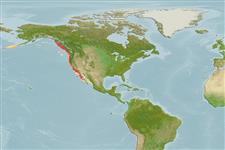Lớp cá viên khẩu (Myxini) (hagfishes) >
Myxiniformes (Hagfishes) >
Myxinidae (Hagfishes) > Eptatretinae
Etymology: Eptatretus: hepta (Gr.), seven; tretos (Gr.), perforated (i.e., with holes), referring to seven gill apertures on what would later be described as Homea banksii (=E. cirrhatus) [range within genus is 6-14 pairs of gill apertures] (See ETYFish); stoutii: In honor of Arthur B. Stout (1814-1898), surgeon and corresponding secretary of the California Academy of Sciences [see box, below] (See ETYFish).
Eponymy: Dr Arthur Breese Stout (1814–1898) was a prominent surgeon in San Francisco. [...] (Ref. 128868), visit book page.
Environment: milieu / climate zone / depth range / distribution range
Sinh thái học
Biển gần đáy; không di cư; Mức độ sâu 16 - 966 m (Ref. 96339). Temperate; 58°N - 20°N, 137°W - 105°W
Eastern Pacific: southeastern Alaska to Bahia San Pablo, central Baja California, Mexico.
Length at first maturity / Bộ gần gũi / Khối lượng (Trọng lượng) / Age
Maturity: Lm 42.0 range ? - ? cm
Max length : 63.5 cm TL con đực/không giới tính; (Ref. 96339)
Các tia vây lưng cứng (tổng cộng) : 0; Các vây lưng mềm (tổng cộng) : 0; Tia cứng vây hậu môn: 0; Tia mềm vây hậu môn: 0. No true fins - one dorsal finfold, far back, median, very low, continuous with caudal; caudal broad, rounded; ventral finfold very low, origin somewhat posterior to last gill pore, extending to anus (Ref. 6885). Dark brown, tan, gray, or brownish red, often tinted with blue or purple, never black, lighter ventrally, rarely with large patches of white; preserved specimens light brown (Ref. 6885).
Inhabits fine silt and clay bottoms (Ref. 6885). Enters large fishes by way of the mouth and anus and feed on its viscera and muscles (Ref. 6885). May greatly diminish catches taken with fixed gears (Ref. 6885). Produces mucilaginous slime when harassed (Ref. 6885). Probably exhibits hermaphroditism (Ref. 56947). Due to its primitive metabolism it is collected for research purposes (Ref. 6885). TBK: demerspelag.
Copulatory organ absent (Ref. 51361). Presence of bisexual juvenile gonad, requires further investigation regarding hermaphroditism (Ref. 56947). In one study (Ref. 40710), hermaphroditism is exhibited by only 0.2% of the individuals studied.
Fernholm, B., 1998. Hagfish systematics. p. 33-44. In J.M. Jørgensen, J.P. Lomholt, R.E. Weber and H. Malte (eds.) The biology of hagfishes. Chapman & Hall, London. 578 p. (Ref. 31276)
IUCN Red List Status (Ref. 130435: Version 2024-1)
Threat to humans
Harmless
Human uses
Các nghề cá: không ích lợi (thú vị); Bể nuôi cá: Bể cá công cộng
Các công cụ
Special reports
Download XML
Các nguồn internet
Estimates based on models
Preferred temperature (Ref.
123201): 5.8 - 9.4, mean 7.1 °C (based on 54 cells).
Phylogenetic diversity index (Ref.
82804): PD
50 = 0.5000 [Uniqueness, from 0.5 = low to 2.0 = high].
Bayesian length-weight: a=0.00288 (0.00169 - 0.00493), b=2.88 (2.73 - 3.03), in cm total length, based on LWR estimates for this species & (Sub)family-body (Ref.
93245).
Mức dinh dưỡng (Ref.
69278): 4.2 ±0.70 se; based on food items.
Thích nghi nhanh (Ref.
120179): thấp, thời gian nhân đôi của chủng quần tối thiểu là 4.5 - 14 năm (Fec = 28).
Fishing Vulnerability (Ref.
59153): Moderate to high vulnerability (45 of 100).
